Japan's only biwa specialty shop, with 140 years of history.
Ishida Biwa Shop
Map >> 37
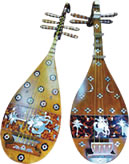
This is the same model of biwa that is housed at Shosoin. Its sales price is a staggering 5 million yen!
The brightly colored biwas (Japanese short-necked lutes) that decorate the storefront are the same model of biwa that is housed at Shosoin. They are constructed by cutting great green turban (a type of shellfish) shell and
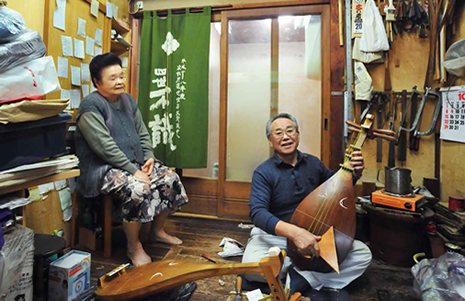
amber and embedding them into the instrument. The man who produced these instruments is Fushiki Ishida, the fourth-generation owner of Ishida Biwa Shop and a living national treasure.
Ishida Biwa Shop first opened in 1878. The first-generation owner was originally a soldier in the Japanese imperial army, and was dispatched to the Satsuma Rebellion. At this time, he was charmed by the tones of the Satsuma biwas that he heard in enemy territory. Following the battle, he resigned from the imperial army, hired a craftsman, and opened Ishida Biwa Shop. The traditions passed down since that time are on another level from other biwa shops, starting with the stocking methods.
Japanese zelkova and mulberry wood, which are used as material, are procured as logs from the island of Mikura-jima. The wood is gathered once every two to three years in January or February, the period when the trees are in hibernation. Volcanic ash is present in Mikura-jima, meaning that during seasons such as spring and fall, when the trees absorb water, blotches are left on the trees, robbing them of their beauty. For this reason, it has been decided that the wood must only be gathered during cold periods.
Next, the wood that has been gathered is dried out. This requires an astounding length of time. The shop has a storehouse in the city of Sakado in Saitama Prefecture where it stores the wood. At this location, the wood used on the surface of the instrument is stored for three to four years, and the wood used on the back, which requires more thickness, is stored for 10 years.
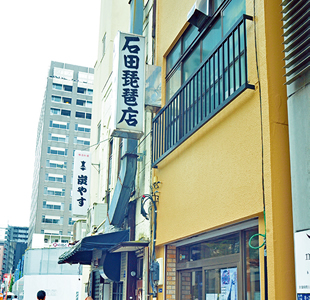
The signboard, which says "Ishida Biwa Shop," points people to the shop.
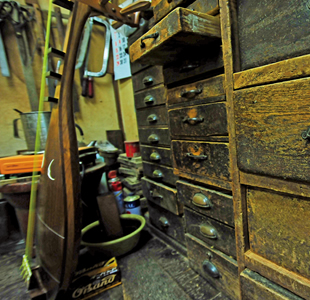
For quite some time, the same drawers have been used. The drawers with round handles are the older ones.
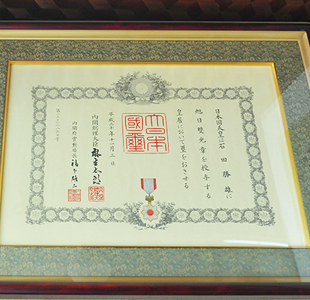
The shop interior is adorned with numerous awards.
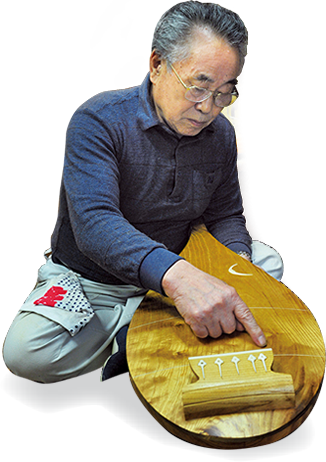
Mr. Ishida verifies the sound of each biwa as he makes it. He adjusts the sound to match the user's voice.
These days, biwas that are mass-produced at instrument shops are often dried in short periods of time using artificial drying machines. However, the reverberation of the sound emitted from the wood differs depending on whether it has been naturally or artificially dried. It is precisely because the traditional Ishida Biwa Shop thoroughly insists on authenticity that it takes the trouble to invest so much time.
Before taking over the shop from the previous-generation owner, Mr. Ishida was a carpenter. As such, he was able to create shapes, but it was difficult for him to produce the ideal sounds. By learning from biwa instructors and traveling to performances, he became aware of the importance of balancing the biwa's sound with the performer's voice. The optimal sound changes based on the character of the performer's voice, such as whether that performer is a man or a woman. In addition, Mr. Ishida says that since minute differences in sound appear based on the grain of the wood, he makes adjustments by altering the thickness on the back.
The strings he uses are also consistent with those used in the past. He uses yellow silk made by Marusan Hashimoto, a shop established in 1908 that is located in Shiga Prefecture, which is known for its production of high-quality raw silk. Since the sound would change with different particle fineness, he only uses Hashimoto silk. There are four levels for the thickness of the strings, another point in which the optimal design differs based on the user.
For biwas, which are made with such investments of time and effort, even the inexpensive models are 350,000 yen. A biwa made entirely of mulberry wood fetches a price in the millions of yen. These instruments are by no means cheap, but the authentic sound is indispensible for one to progress as a performer. In fact, the biwa I was able to hear when conducting this coverage had a sound that profoundly moved me to my core.
The traditions of Ishida Biwa Shop, which have carried on for 140 years, will be inherited by the owner's son, who himself is a performer and is aware of the biwa's authentic sound.
SHOP DATA
| Address: | 3-8-4 Toranomon, Minato-ku, Tokyo |
| Phone: | 03-3431-6548 |
| Hours: | 9:00 AM to 5:00 PM (Monday to Saturday) |
| Closed: | Sundays and national holidays |
| Access: | A 5-minute walk from Toranomon Station on the Tokyo Metro Ginza Line |











